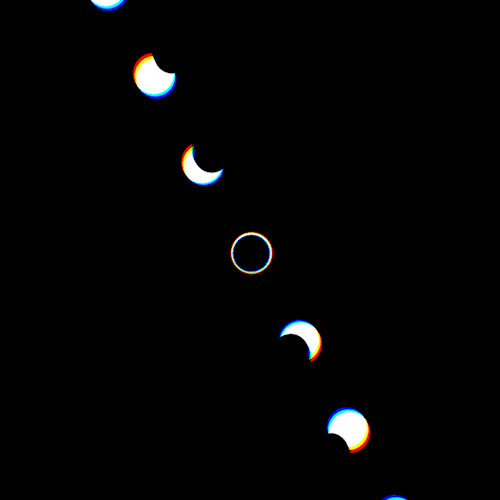Sublimist - SUBLIMIST

More Posts from Sublimist and Others

a wishing well that all men call the world: earth against the stars, photographed by soho and dscovr, 18th november 2015.
a composite of real imagery: earth is photographed by dscover’s epic instrument (11 times over 22 hours), but epic exposures are too short to pick up stars; instead, i have used a starfield synthesized from soho images earlier in the year when the sun was moving through taurus and auriga, where the earth is now. the framing of the images and the apparent motion of the stars are also based on soho images.
the numerous inaccuracies and creative slights of hand are mine.
image credit: nasa/soho, nasa/noaa. animation&composite: ageofdestruction. title: leonard cohen.
( i balance on a wishing well that all men call the world we are so small between the stars so large against the sky and lost among the subway crowds i try to catch your eye - )


eclipse










The Most Beautiful Mathematical Equations. 1. General Relativity The equation above was formulated by Einstein as part of his groundbreaking general theory of relativity in 1915. The theory revolutionized how scientists understood gravity by describing the force as a warping of the fabric of space and time. The right-hand side of this equation describes the energy contents of our universe (including the ‘dark energy’ that propels the current cosmic acceleration). The left-hand side describes the geometry of space-time. The equality reflects the fact that in Einstein’s general relativity, mass and energy determine the geometry, and concomitantly the curvature, which is a manifestation of what we call gravity. 2. Standard Model This equation describes the collection of fundamental particles currently thought to make up our universe. It has successfully described all elementary particles and forces that we’ve observed in the laboratory to date - except gravity, including recently discovered Higgs boson and phi in the formula. It is fully self-consistent with quantum mechanics and special relativity. 3. The Fundamental Theorem of Calculus This equation forms the backbone of the mathematical method known as calculus, and links its two main ideas, the concept of the integral and the concept of the derivative. It allows us to determine the net change over an interval based on the rate of change over the entire interval. The seeds of calculus began in ancient times, but much of it was put together in the 17th century by Isaac Newton, who used calculus to describe the motions of the planets around the sun. 4. 1 = 0.999999999…. This simple equation states that the quantity 0.999 followed by an infinite string of nines is equivalent to one, and is made by mathematician Steven Strogatz of Cornell University. Many people don’t believe it could be true. It’s also beautifully balanced. The left side represents the beginning of mathematics; the right side represents the mysteries of infinity. 5. Special Relativity Einstein makes the list again with his formulas for special relativity, which describes how time and space aren’t absolute concepts, but rather are relative depending on the speed of the observer. It shows how time dilates, or slows down, the faster a person is moving in any direction. 6. Euler’s Equation This simple formula encapsulates something pure about the nature of spheres. It says that if you cut the surface of a sphere up into faces, edges and vertices, and let F be the number of faces, E the number of edges and V the number of vertices, you will always get V – E + F = 2. So, for example, take a tetrahedron, consisting of four triangles, six edges and four vertices. If you blew hard into a tetrahedron with flexible faces, you could round it off into a sphere, so in that sense, a sphere can be cut into four faces, six edges and four vertices. And we see that V – E + F = 2. Same holds for a pyramid with five faces - four triangular, and one square - eight edges and five vertices, and any other combination of faces, edges and vertices. The combinatorics of the vertices, edges and faces is capturing something very fundamental about the shape of a sphere. 7. Euler–Lagrange Equations and Noether’s Theorem In this equation, L stands for the Lagrangian, which is a measure of energy in a physical system, such as springs, or levers or fundamental particles. Solving this equation tells you how the system will evolve with time. A spinoff of the Lagrangian equation is called Noether’s theorem. Informally, the theorem is that if your system has a symmetry, then there is a corresponding conservation law. For example, the idea that the fundamental laws of physics are the same today as tomorrow (time symmetry) implies that energy is conserved. The idea that the laws of physics are the same here as they are in outer space implies that momentum is conserved. 8. The Callan-Symanzik Equation Basic physics tells us that the gravitational force, and the electrical force, between two objects is proportional to the inverse of the distance between them squared. However, tiny quantum fluctuations can slightly alter a force’s dependence on distance, which has dramatic consequences for the strong nuclear force. What the Callan-Symanzik equation does is relate this dramatic and difficult-to-calculate effect, important when the distance is roughly the size of a proton, to more subtle but easier-to-calculate effects that can be measured when the distance is much smaller than a proton. 9. The Minimal Surface Equation The minimal surface equation somehow encodes the beautiful soap films that form on wire boundaries when you dip them in soapy water. The fact that the equation is ‘nonlinear,’ involving powers and products of derivatives, is the coded mathematical hint for the surprising behavior of soap films.

test_287


one hertz

-
 enchantingcolortacogarden liked this · 2 years ago
enchantingcolortacogarden liked this · 2 years ago -
 2sundowner69 reblogged this · 2 years ago
2sundowner69 reblogged this · 2 years ago -
 valtinok liked this · 10 years ago
valtinok liked this · 10 years ago -
 omar-22fan liked this · 10 years ago
omar-22fan liked this · 10 years ago -
 omar-22fan reblogged this · 10 years ago
omar-22fan reblogged this · 10 years ago -
 sublimist reblogged this · 10 years ago
sublimist reblogged this · 10 years ago -
 needing-prozac reblogged this · 10 years ago
needing-prozac reblogged this · 10 years ago -
 needing-prozac liked this · 10 years ago
needing-prozac liked this · 10 years ago -
 c-83 reblogged this · 10 years ago
c-83 reblogged this · 10 years ago -
 mustakrab liked this · 11 years ago
mustakrab liked this · 11 years ago -
 rigan323 reblogged this · 11 years ago
rigan323 reblogged this · 11 years ago -
 sweetcherry567 reblogged this · 11 years ago
sweetcherry567 reblogged this · 11 years ago -
 sweetcherry567 liked this · 11 years ago
sweetcherry567 liked this · 11 years ago -
 abrasivejazz reblogged this · 11 years ago
abrasivejazz reblogged this · 11 years ago -
 my-mindspeaking reblogged this · 11 years ago
my-mindspeaking reblogged this · 11 years ago -
 myguiltypleassure liked this · 11 years ago
myguiltypleassure liked this · 11 years ago -
 kieran-has-a-blog liked this · 11 years ago
kieran-has-a-blog liked this · 11 years ago -
 rigan323 liked this · 11 years ago
rigan323 liked this · 11 years ago -
 sigotuluzaunquemelleveamorir reblogged this · 11 years ago
sigotuluzaunquemelleveamorir reblogged this · 11 years ago -
 sigotuluzaunquemelleveamorir liked this · 11 years ago
sigotuluzaunquemelleveamorir liked this · 11 years ago -
 matthewcamp reblogged this · 11 years ago
matthewcamp reblogged this · 11 years ago -
 the-youngadult reblogged this · 11 years ago
the-youngadult reblogged this · 11 years ago -
 iron-v reblogged this · 11 years ago
iron-v reblogged this · 11 years ago

